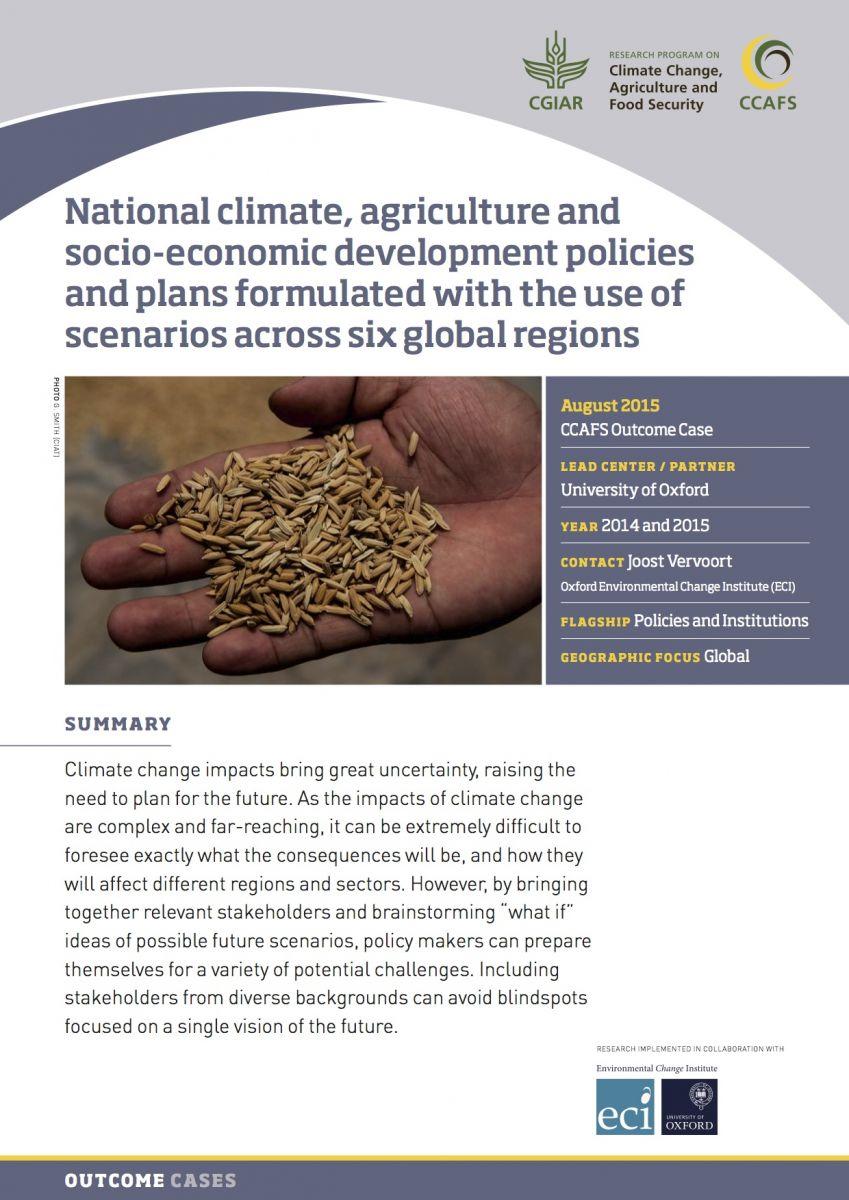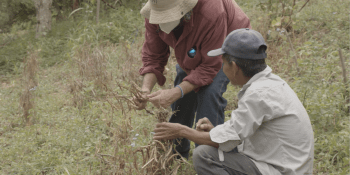Future Scenarios work informs climate and agriculture policies in seven countries

Scenarios work makes headway as it now informs climate, agriculture and socio-economic development policies across seven countries.
The impacts and consequences of a changing climate on the world’s vulnerable regions are and will be far-reaching; many specifics of future climate change are still unpredictable and uncertain.
Moreover, many other developments, such as economic, social, political, and environmental changes, will determine whether vulnerable regions will suffer or be able to adapt in the face of climate change.
Developing long-term plans for a country’s agricultural sector and climate adaptation strategies can therefore feel very daunting to policy-makers.
The CGIAR Research Program on Climate Change, Agriculture and Food Security (CCAFS) saw the need to provide policymakers and advisors with tools that support future decision-making under climate change. Through the years, this work has evolved into what is today called the 'Future Scenarios' project.
The approach explores diverse 'scenario worlds' to help stress test and develop plans and policies that have to deal with uncertain climate and socio-economic futures.
The work was developed by a CCAFS team at the University of Oxford's Environmental Change Institute, and is now making a mark on the policy landscape across seven global regions.
In fact, the CCAFS scenarios project is today informing climate, agriculture and socio-economic development policies in seven countries, with a number of additional policy processes in progress.
Using scenarios to guide policies
The scenarios work brings together stakeholders to outline relevant drivers of future change in their region. These factors can range from climate change, population growth, urbanization, private sector development, or health and disease developments.
Participants use a combination of these drivers to create different future ‘what if’ scenarios. Each scenario describes how the future could develop if drivers co-evolve in a certain direction.
Each scenario is then used to review a draft government plan or strategy. This stage can help identify different weaknesses and strengths in the draft, and detailed, scenario-specific recommendations help to further guide the process.
The scenario recommendations can be either combined or integrated into the plan and help make sure it is achievable and more robust in the face of very different futures.
By including stakeholders from diverse backgrounds, such as farmers’ associations, the private sector, development organizations and scientists, the scenario-guided policy-planning process can incorporate diverse voices into more transparent and inclusive planning processes.
The scenarios are quantified to regional and national scenarios using the IMPACT model by the International Food Policy Research Institute (IFPRI) and GLOBIOM developed by the International Institute for Applied Systems Analysis (IIASA), which help to provide detailed information on each of the scenarios, making in-depth policy analysis more effective.
 Stakeholders outline future scenarios in the context of climate change to further develop Tanzania’s New Environmental Policy. Photo: E. van de Grift
Stakeholders outline future scenarios in the context of climate change to further develop Tanzania’s New Environmental Policy. Photo: E. van de Grift
The idea is that by integrating scenario-based recommendations developed through participatory sessions into policy-making processes, planners can generate a better, more enabling environment for climate resilience. Scenario-based recommendations are now informing the following plans:
- Honduras: National Strategy for Climate Change Adaptation in Agriculture
- Cambodia: Climate Change Priorities Action Plan
- Bangladesh: 7th Five year plan
- Tanzania: New Environmental Policy
- Uganda: Agricultural Sector Plan
- Burkina Faso: National Plan for the Rural Sector
- Colombia: Action Plan for the National Agricultural Adaptation Strategy
- Ghana: National Climate Change Policy [related story]
Lessons learned
Since the scenarios work within CCAFS started, a few key lessons have been learned along the way.
For one thing, it is imperative to engage stakeholders from a variety of groups to include different perspectives regarding potential future climate and socio-economic scenarios. Building trust and a close working relationship with government teams in each policy case will support more timely applications and ownership of the process.
In addition, focusing energy on specific policies generates greater impact, as policy-makers and others do not have to start from scratch, but can strengthen their existing policy processes using the recommendations that come out of participatory scenario-guided policy analysis.
To make all of this possible, the original regional scenarios have to be legitimate and credible as well as flexible enough to be adapted to a wide range of specific policy contexts.
Dedicated work in all program regions has made sure future scenarios provide an effective and inclusive supporting approach for decision-making processes to help policymakers ‘future-proof’ their plans.
Video of scenario-guided policy planning work in Uganda and Tanzania
Learn more:
- Outcome story: National climate, agriculture and socio-economic development policies and plans formulated with the use of scenarios across six global regions
- Read other Future Scenario blogs
- Article: Challenges to scenario-guided adaptive action on food security under climate change
- Project Page: Scaling out scenario-guided policy and investment planning
Story by Cecilia Schubert, Communication Officer CCAFS Flagship on Policies and Institutions. Joost Vervoort is the CCAFS Scenarios Officer. Interested in policies and institutions for climate-resilient food systems? Subscribe to our newsletter.






